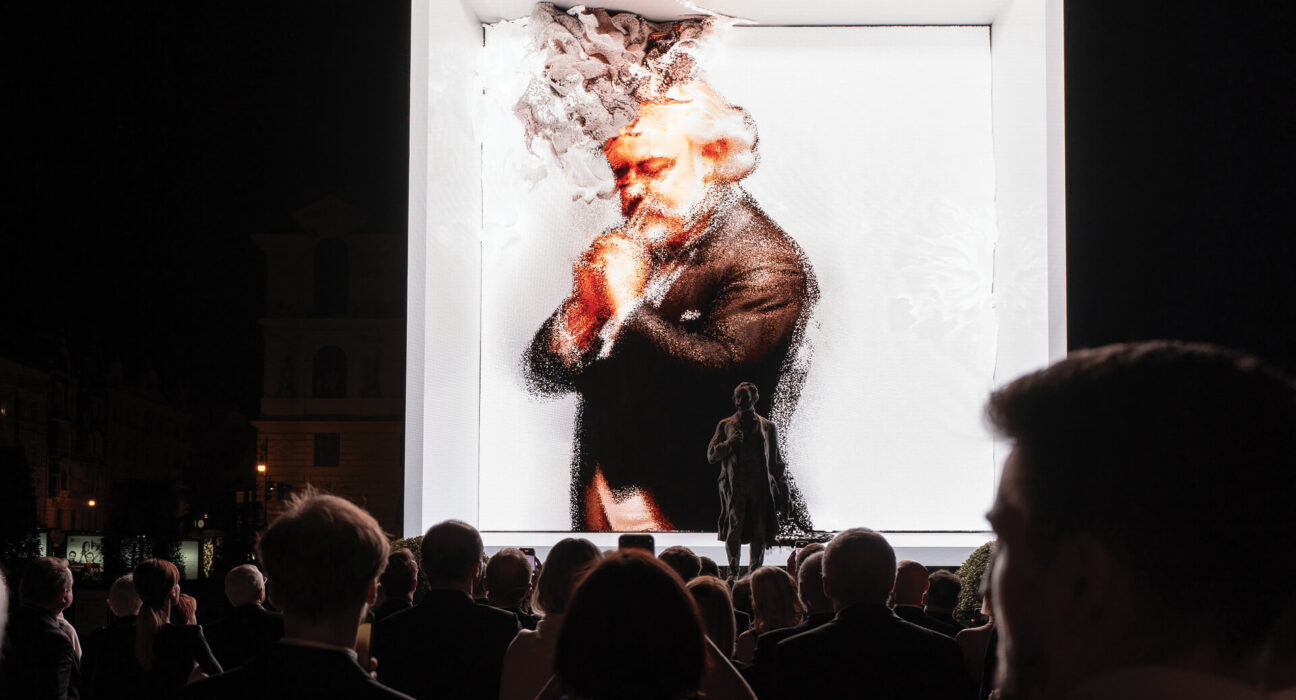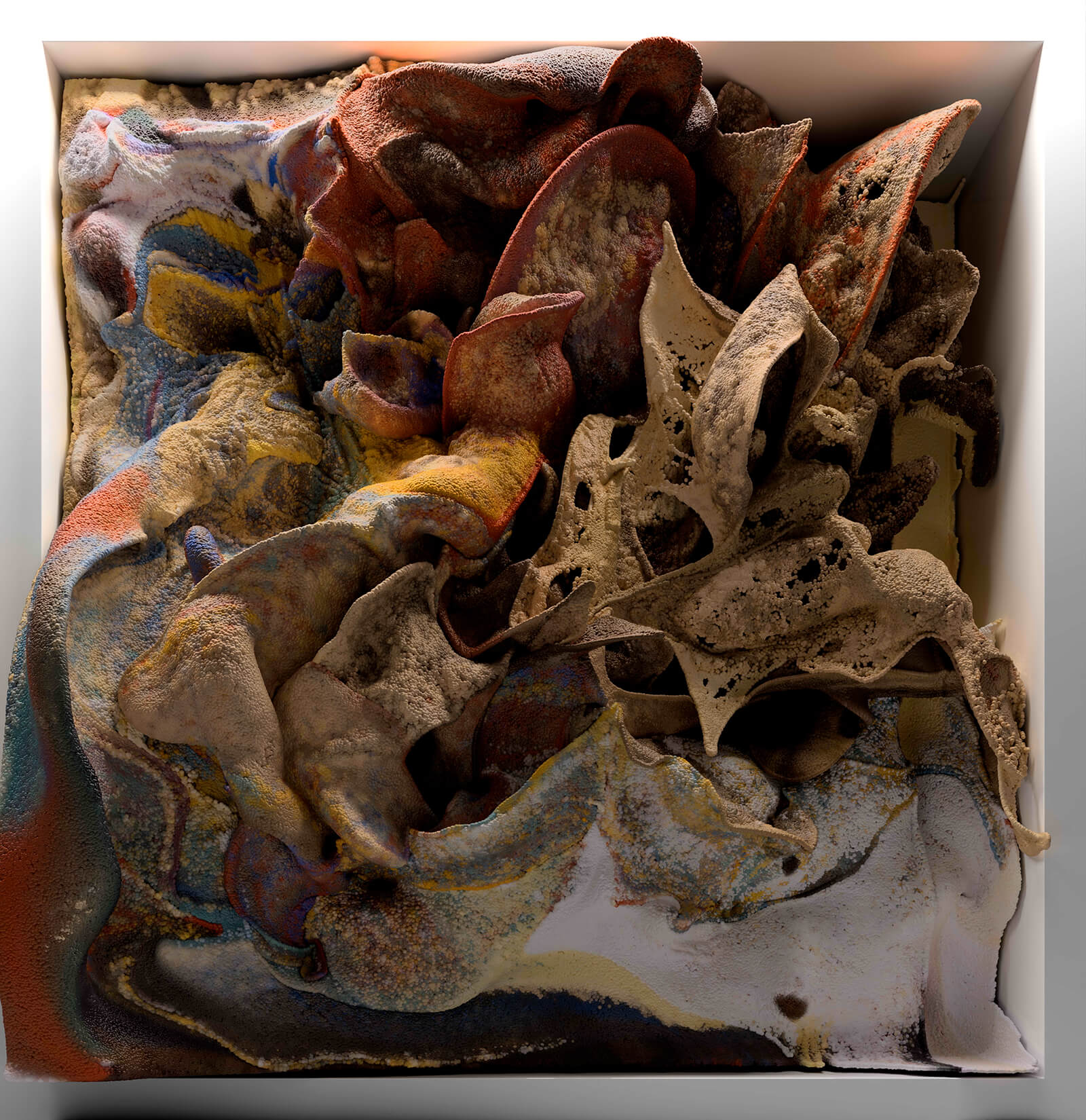Dvořák Dreams (2023) by Refik Anadol is a large artificial intelligence (AI) art sculpture that pays tribute to the highly acclaimed Czech composer Antonín Leopold Dvořák, and was installed in Jan Palach Square in Old Town (Staré Mesto) in Prague, the Czech Republic (September 8-13, 2023). Dvořák is celebrated for integrating folk music traditions from Moravia and Bohemia, which form the modern-day Czech Republic (along with Czech Silesia). Like much of Anadol’s practice, the work presents visuals that seem as though digital data itself is shifting and roiling before viewers’ eyes. However, in a major departure for the new media artist, the visuals of Dvořák Dreams also include representational elements of the Czech composer to whom it pays tribute.
Dvořák Dreams has been installed in front of the Rudolfinum Concert Hall, which is considered the most prestigious venue for classical music in the Czech Republic and is a location that has particular significance to the composer’s legacy: it was here, in 1896, that the Czech Philharmonic performed for the first time, with Dvořák at its helm. The digital sculpture art piece was commissioned by 0xCollection, pronounced “Hex Collection”, an initiative founded by Czech entrepreneur Karel Komárek, that collects new media and digital artworks by acclaimed contemporary practitioners. Komárek is also a co-founder of the Dvořák Prague Festival, a music festival dedicated to classical forms, and Dvořák Dreams was commissioned ahead of this year’s edition (September 7-25). It is the collection’s inaugural public presentation and its development received support from the international lottery operator Allwyn.
Elle Anastasiou, the director of the 0xCollection sheds some light on the artwork, in an interview with STIR. She begins by making an important distinction, “Dvořák Dreams was not simply derived from the composer’s archival imagery and AI-harvested biographical information. Rather, it was meticulously crafted through Refik Anadol’s artistic intervention, in order to illuminate the pivotal chapters of Dvořák’s life that facilitated his ongoing resonance as a musical pioneer on an international scale.”
The AI art sculpture is composed of four chapters that move sequentially from Dvořák’s childhood in Nelahozeves, near Prague, which was then a part of the Austrian Empire; on to Prague, which is where he rose to prominence; and from there to New York, where he composed his most notable works, especially his New World Symphony (1893). Finally, the fourth chapter blends the first three with an animation of the composer conducting; something Anastasiou points out is a first for Anadol’s highly fluid style composed of minute particles, which he refers to as “data painting”, and is usually seen in more abstract compositions by the new media artist, rather than representational ones.
Anadol and 0xCollection aligned on their shared vision to present an interdisciplinary fusion of Czech cultural heritage and cutting-edge digital art. Dvořák Dreams’ accompanying soundscape was created through Anadol’s use of multiple audio algorithms, which Anastasiou believes marks a significant milestone for his studio. She explores the artist’s process, telling STIR, “Through sourcing 2,400 files of Dvořák performances, amounting to 55 hours of training data, the artist conducted a harmonic analysis of the composer’s entire musical corpus. Subsequently, neural networks were employed to cluster this data, providing a comprehensive map of Dvorak’s works—this was akin to a study of harmonic progression.” Finally, Anadol utilised the aforementioned algorithms to translate this data into a soundscape. In Anastasiou’s words, “This process was an intimate one, aiming to delicately transform this extensive amount of raw musical data into a composition, harmonising a distinctive movement with each narrative chapter.”
Dvořák Dreams was undoubtedly a valuable addition to the Dvořák Prague Festival, however, it raises a question of primacy, between artistic medium and artistic expression. How should audiences interpret the installation? Should it be seen as a visual tapestry that reshapes their understanding of Dvořák’s musical expression through the visual medium? Or, are we to treat it as one of many possible contemporary entry points to understanding Dvořák’s artistic expression, extending beyond the visual and sonic mediums? In response, Anastasiou says, “In my opinion, Dvořák Dreams cannot be compartmentalised into either audio or visual formats. The work, within itself, was created as a piece of synergy between disparate artistic formats and it is only through viewing the entirety of the data sculpture that the entire input narrative, output experience and overarching context can be fully appreciated.”
Anastasiou adds that the project’s objective is not solely to develop an understanding of Dvořák from a multidisciplinary point of view. Rather, Dvořák Dreams was created to transform an existing legacy with utmost respect, which is a position that she tells us Anadol shares.


